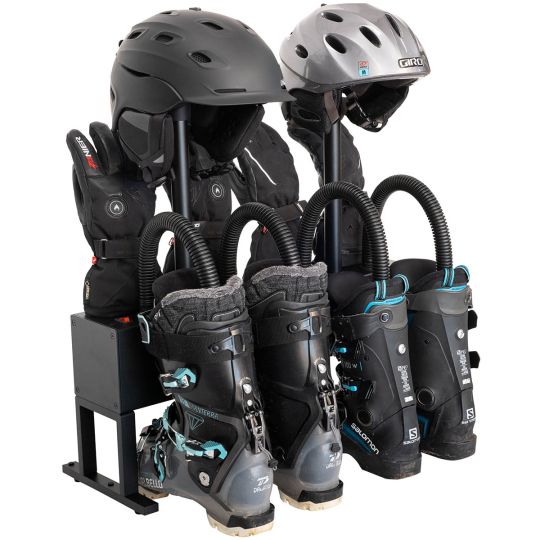Alpine Dryers Blog
Why Altitude Ruins Your Drying Time (And What Mountain Towns Do About It)
Why Altitude Ruins Drying Time: High Elevation Gear Drying Solutions | Alpine Dryers
by Alpine Dryers • June 22, 2025
Ever wonder why your ski boots take forever to dry in Aspen but seem fine at sea level? Or why that same gear dryer that worked perfectly in your garage suddenly feels weak after you moved to the mountains?
Here's what's happening: altitude is quietly sabotaging your drying time, and most people have no idea.
How Does Elevation Actually Affect Drying?
Air pressure drops as you go higher. At sea level, air pressure is about 14.7 pounds per square inch. At 8,000 feet (typical Colorado ski town), it's only 10.9 PSI. That's 26% less air pushing moisture out of your gear.
Lower air pressure means slower evaporation. Think of it like this: water molecules need energy to escape from wet fabric. At high altitude, there's less atmospheric pressure holding them down, but there's also less dense air to carry that moisture away.
The real kicker? Most people blame their dryer when altitude is the actual culprit.
What Altitude Does to Different Drying Methods
Air-drying becomes almost useless above 6,000 feet. That wet gear hanging in your mudroom? It might take 2-3 times longer to dry than it would at sea level.
Basic fan-driven dryers struggle because they're moving thinner air with less moisture-carrying capacity. The fans work just as hard but accomplish less.
Heat-based drying gets complicated because water boils at lower temperatures at altitude (190°F at 10,000 feet vs. 212°F at sea level), but humidity behaves differently too.
Why Mountain Towns Need Different Drying Solutions
High-altitude communities figured this out years ago. Walk into any ski lodge in Vail, Jackson Hole, or Park City, and you'll notice something: their gear drying systems are beefier than what you'd find at lower elevations.
Smart mountain towns use airflow, not just heat. Alpine Dryers systems work well at altitude because they focus on high-velocity air movement rather than relying solely on temperature changes.
The locals know: you need more CFM (cubic feet per minute) of airflow to compensate for thinner air. It's basic physics that most coastal manufacturers don't consider.
Real-World Altitude Drying Challenges
Ski resort scenario: Your boots get soaked during a powder day at 9,000 feet. With regular air-drying, they're still damp the next morning. With inadequate forced-air drying, they're barely ready for afternoon runs.
Mountain town living: You move from Portland to Breckenridge and suddenly your trusty boot dryer from sea level takes twice as long. Your gear stays damp, starts smelling funky, and develops mold faster.
High-altitude work sites: Construction crews, oil rig workers, and outdoor professionals at elevation deal with this constantly. Wet boots don't just mean discomfort - they mean safety risks and health problems.
The Science Behind High-Altitude Drying
Air density matters more than temperature. At 10,000 feet, air is about 30% less dense than at sea level. That means each cubic foot of air can carry less moisture away from your gear.
Humidity behaves differently at altitude. The relative humidity might read the same, but the absolute moisture content is much lower, which sounds good for drying but actually slows the process.
Pressure differentials change everything. Lower atmospheric pressure means moisture doesn't get "pulled" out of materials as effectively.
What Works (And What Doesn't) at High Elevation
High-velocity airflow systems work best. You need to move more air volume to compensate for lower density. Systems designed for mountain conditions understand this principle.
Gentle heat plus airflow beats high heat alone. Cranking up temperature without increasing airflow just wastes energy and can damage gear.
Ambient air drying is basically useless above 8,000 feet, especially in winter when outdoor humidity is low but indoor heating creates its own moisture problems.
How Mountain Professionals Handle Gear Drying
Ski patrol teams use commercial-grade forced-air systems because their gear needs to be ready for the next emergency, regardless of overnight weather.
Mountain rescue operations can't afford to have wet gear slow them down. They invest in high-CFM drying systems that work reliably at elevation.
Alpine construction crews learned that standard gear dryers don't cut it. They need systems specifically designed for thin air and extreme conditions.
Quick Altitude Drying Reality Check
Your location matters: Look up your elevation. If you're above 5,000 feet, standard drying advice doesn't apply to you.
Your equipment needs might be different: That consumer-grade dryer might work fine for your friend in Florida but struggle in your Colorado cabin.
Time expectations should adjust: What takes 4 hours at sea level might take 6-8 hours at altitude with the same equipment.
The Bottom Line on High-Altitude Drying
Elevation isn't just about scenic views - it fundamentally changes how moisture behaves and how quickly gear dries.
Mountain communities need mountain solutions. Equipment designed for sea level often underperforms when the air gets thin.
Most people living or working at altitude never connect their drying struggles to physics. They assume their gear is just harder to dry or their equipment isn't working properly.
Ready to solve your high-altitude drying challenges? Understanding the science is the first step. Choosing equipment designed for your elevation is the second.

